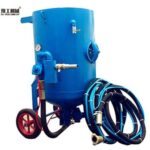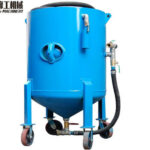Dustless sand blasting machine is a surface preparation device that combines abrasive blasting with water to suppress dust during operation. It uses a mixture of abrasive material, water, and compressed air to clean, smooth, or etch surfaces. The addition of water significantly reduces airborne particles, making the process safer for workers and compliant with environmental standards. The machine is designed for multiple uses including rust removal, paint stripping, surface restoration, and industrial cleaning. It is widely applied in construction, shipbuilding, automotive, oil and gas, and manufacturing industries.
Types of Sand Blasting Machine
The market offers diverse configurations tailored to specific industrial needs:
- Portable Dustless Blasters
Ideal for small-scale projects or on-site applications, these compact units feature wheels for easy maneuverability. They are commonly used in automotive restoration, graffiti removal, and historic building renovation. - Stationary Industrial Systems
Designed for heavy-duty applications in manufacturing plants, these systems handle large volumes of abrasive media and integrate with automated production lines. - Wet Blasting Machines
By mixing water with abrasive media, these systems eliminate dust entirely while reducing friction-induced heat. They are preferred for delicate surfaces like electronics or aerospace components.
Advantages of Using A Dustless Sand Blasting Machine
- Improved Worker Safety: The suppression of airborne dust minimizes risks of respiratory problems and silica exposure.
- Environmental Compliance: Helps companies meet air quality regulations and environmental laws.
- Versatile Applications: Suitable for steel, concrete, wood, glass, stone, and other surfaces.
- Faster Cleaning: The wet abrasive method reduces friction heat, allowing for quicker paint or coating removal.
- Surface Quality: Provides a smoother finish without warping delicate materials.
- Cost Savings: Reduced cleanup time and improved efficiency lower overall operational costs.
Industries Benefiting from Dustless Technology
The versatility of dustless sand blasting machines has led to their adoption across multiple sectors:
- Automotive & Aerospace: Precision surface preparation for painting and bonding
- Construction: Concrete restoration and graffiti removal
- Marine: Ship hull cleaning and corrosion control
- Oil & Gas: Pipeline maintenance and equipment refurbishment
Working Principle of a Dustless Sand Blaster
The dustless sand blasting machine operates by mixing water, abrasive media, and compressed air in a pressurized tank. The mixture is then delivered through a blasting hose and nozzle to the target surface.
- Step 1: Loading: The operator fills the tank with abrasive media and water.
- Step 2: Pressurization: Compressed air pressurizes the tank to create the blasting force.
- Step 3: Blasting: The mixture exits the nozzle at high velocity, impacting the surface to remove rust, paint, or contaminants.
- Step 4: Dust Capture: Water binds with particles, preventing them from becoming airborne.
- Step 5: Cleanup: The process leaves behind a slurry that is easier to collect and dispose of.
How to Choose the Right Sand Blasting Machine?
When selecting a dustless sand blasting machine, consider the following factors:
- Project Requirements: Define whether you need the machine for heavy industrial work, automotive restoration, or residential use.
- Machine Size and Portability: Choose between stationary and mobile units based on job locations.
- Abrasive Compatibility: Ensure the machine supports the type of abrasive media required for your projects.
- Tank Capacity: Larger tanks are better for extended operations, while smaller tanks suit short tasks.
- Durability and Build Quality – Invest in a machine built from high-quality materials to withstand frequent use.



